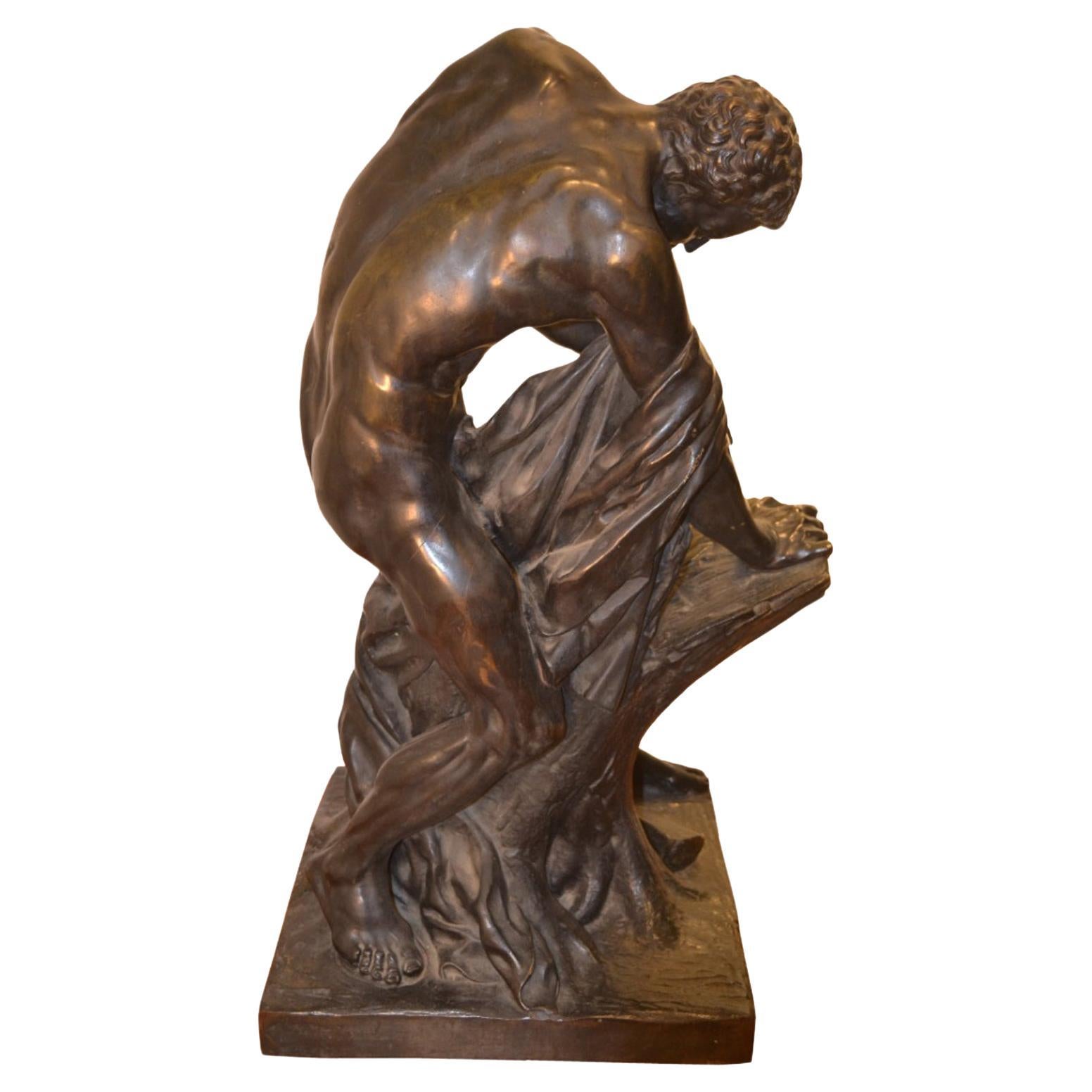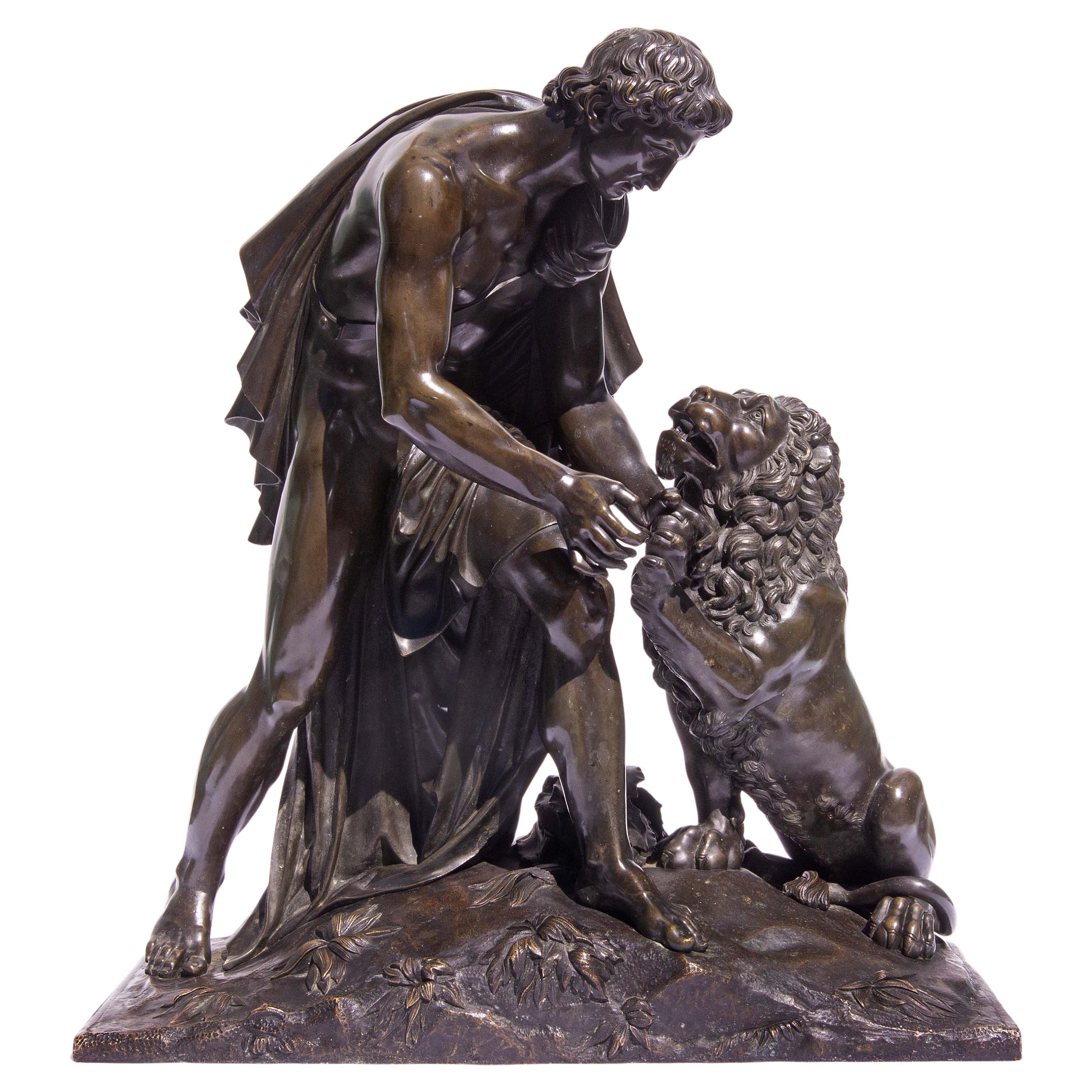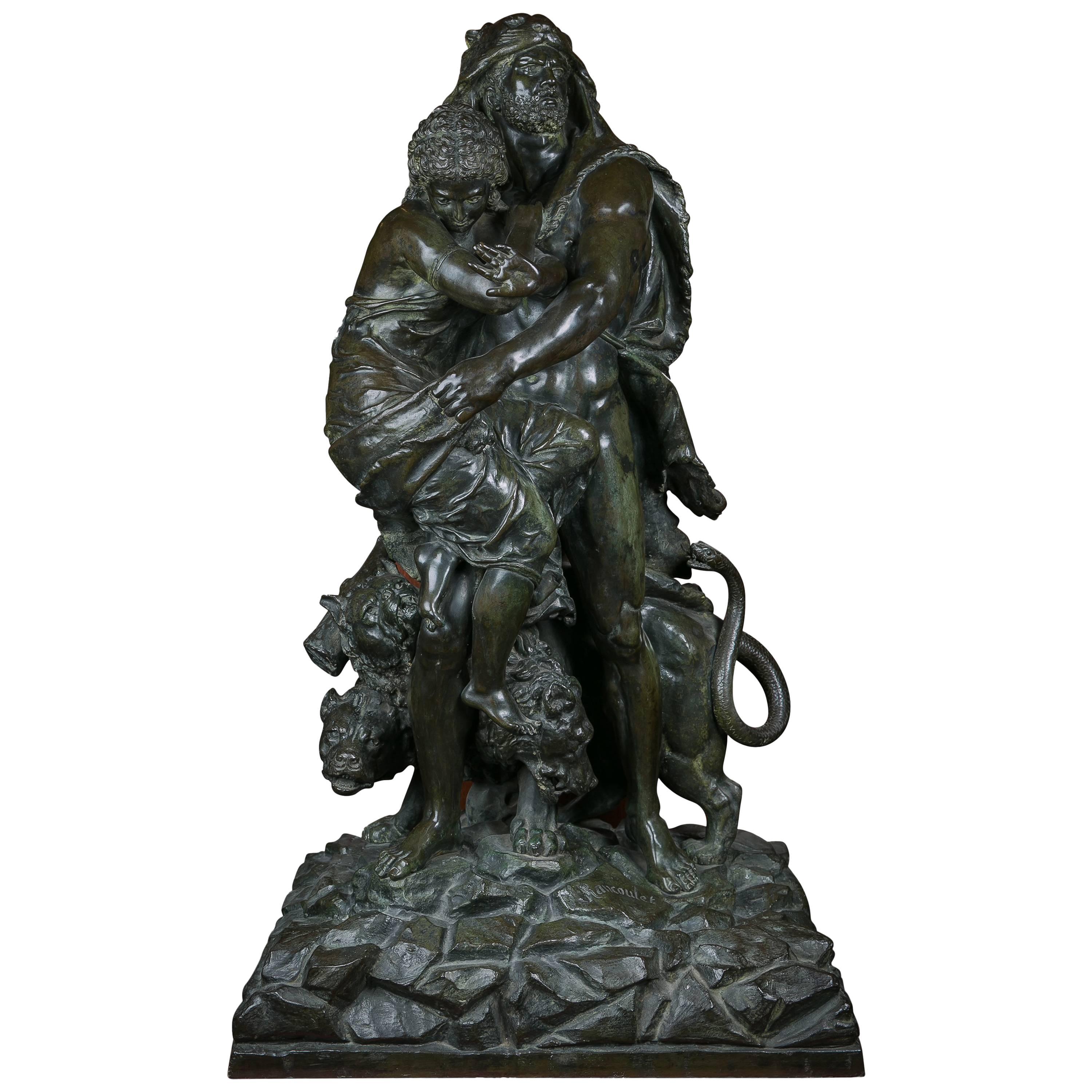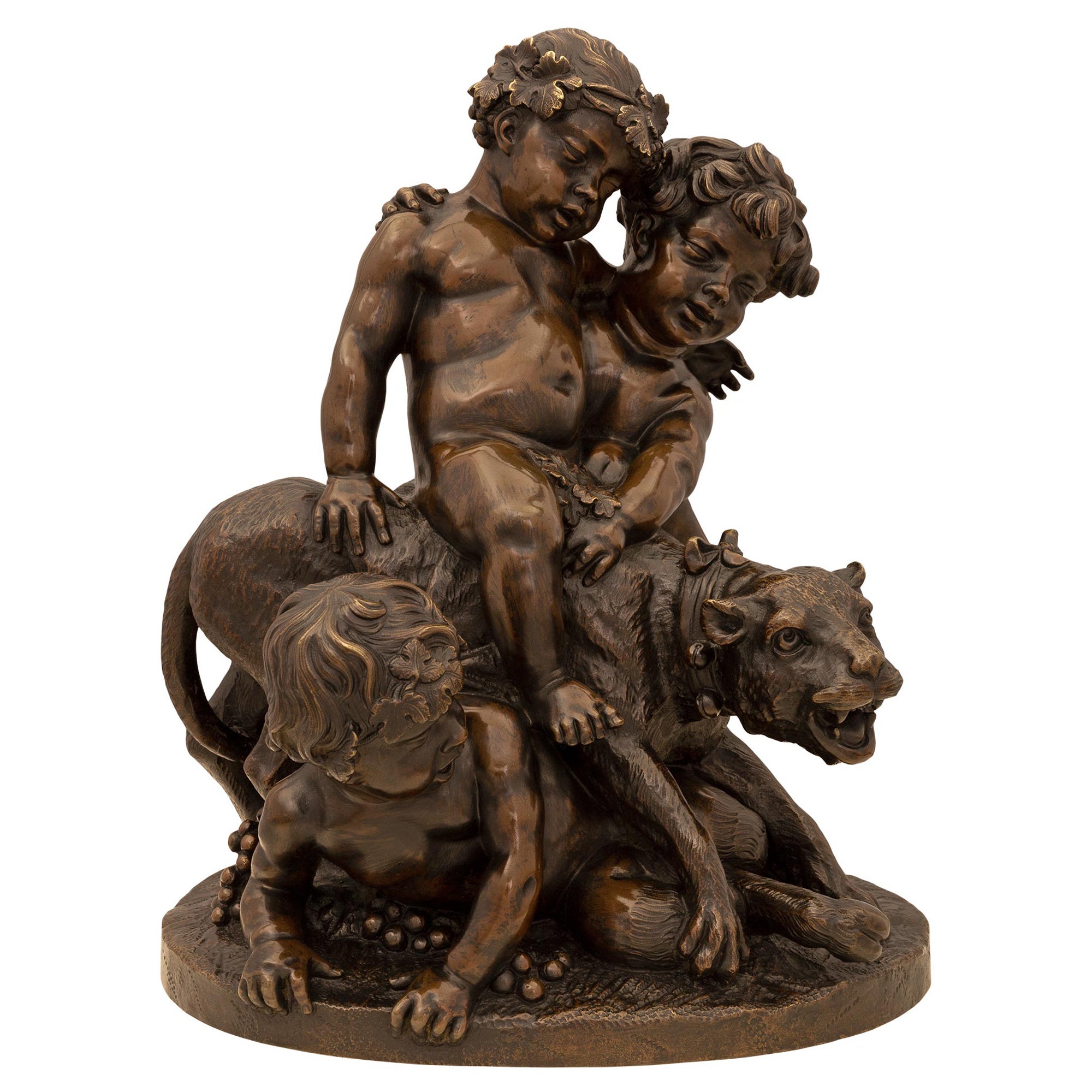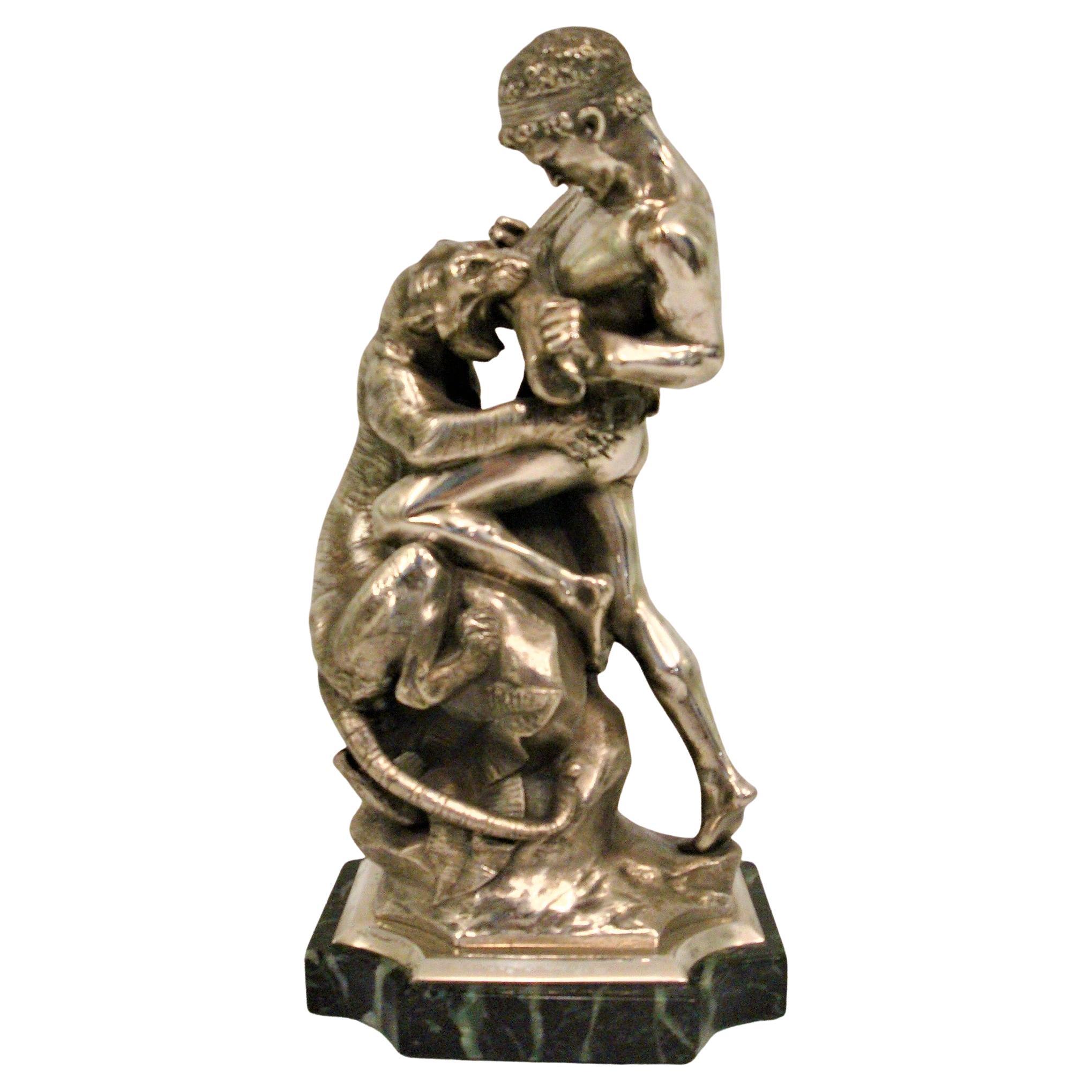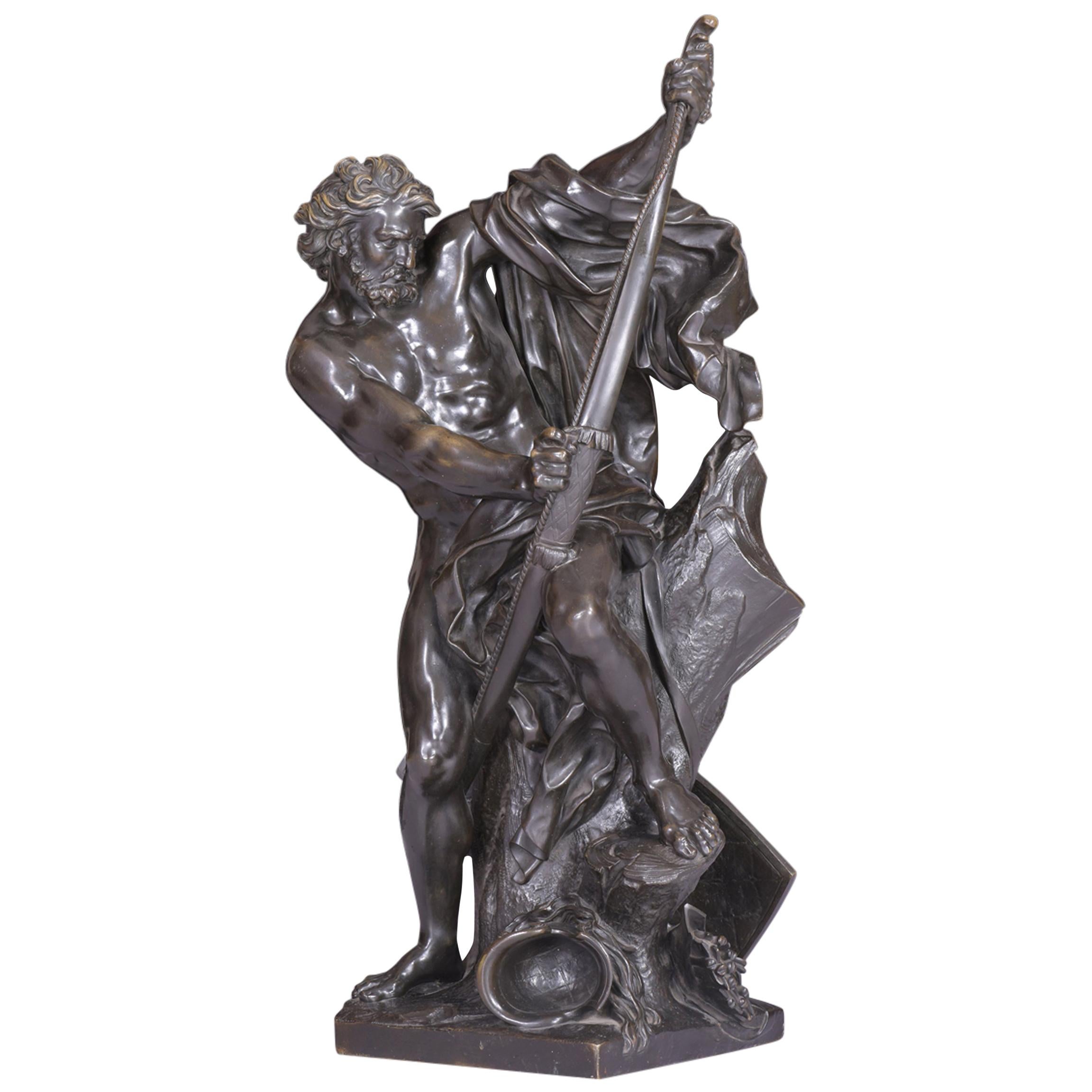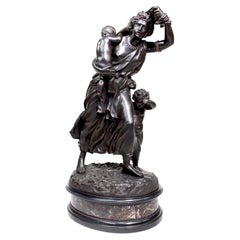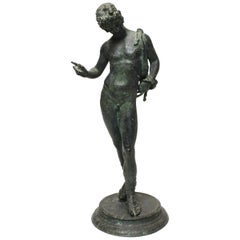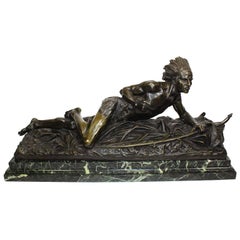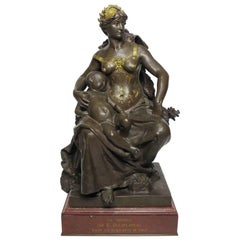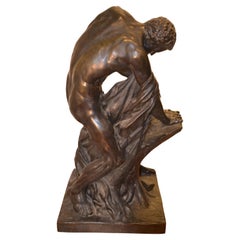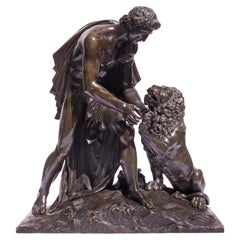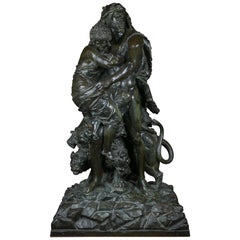Items Similar to Fine French 19th Century Bronze Figure of "Milo of Croton & Lion" After Falconet
Want more images or videos?
Request additional images or videos from the seller
1 of 12
Fine French 19th Century Bronze Figure of "Milo of Croton & Lion" After Falconet
$12,450
$18,45032% Off
£9,388.54
£13,913.1332% Off
€10,858.29
€16,091.2032% Off
CA$17,467.28
CA$25,885.2532% Off
A$19,415.97
A$28,773.0732% Off
CHF 10,177.44
CHF 15,082.2232% Off
MX$237,115.98
MX$351,388.7432% Off
NOK 127,059.41
NOK 188,292.8632% Off
SEK 119,539.20
SEK 177,148.4632% Off
DKK 81,043.14
DKK 120,100.0732% Off
About the Item
A very fine French 19th century Patinated bronze Figure of "Milo of Croton and the Lion" after the marble sculpture of Milon de Crotone by renown French sculptor Étienne Maurice Falconet (1 December 1716 – 24 January 1791) currently at the Louvre Museum in Paris, France and another example in bronze at the Hermitage Museum in Saint Petersburg, Russia. The finely executed bronze sculpture depicting the 6th century BC wrestler, from the Magna Graecian City of Croton, as a nude and muscular male wrestler, resting on his back, holding on to a tree trunk as he fights off an attack by a lion who is biting him on the leg, in a brown patina and raised on a green marble plinth. Incised: Falconet. Paris, circa 1870-1880.
Measures: Overall height 19 1/4 inches (49 cm)
Bronze height 17 1/4 inches (43.5 cm)
Width 15 1/2 inches (39.5 cm)
Depth 12 inches (30.5 cm)
Étienne Maurice Falconet (1716-1791) was a French baroque, rococo and neoclassical sculptor, best-known for his equestrian statue of Peter the Great, the Bronze Horseman (1782), in St. Petersburg, Russia, and for the small statues he produced in series for the Royal Sévres Porcelain Manufactory.
Falconet was born to a poor family in Paris. He was at first apprenticed to a carpenter, but some of his clay figures, with the making of which he occupied his leisure hours, attracted the notice of the sculptor Jean-Baptiste Lemoyne, who made him his pupil. One of his most successful early sculptures was of Milo of Croton, which secured his admission to the membership of the Académie des beaux-arts in 1754.
He came to prominent public attention in the Salons of 1755 and 1757 with his marbles of L'Amour and the Nymphe descendant au bain (also called The Bather), which is now at the Louvre. In 1757 Falconet was appointed director of the sculpture atelier of the new Manufacture royale de porcelaine at Sèvres, where he brought new life to the manufacture of small sculptures in unglazed soft-paste porcelain figurines that had been a specialty at the predecessor of the Sèvres manufactory, Vincennes.
The influence of the painter François Boucher and of contemporary theater and ballet are equally in evidence in Falconet's subjects, and his sweet, elegantly erotic, somewhat coy manner. Right at the start, Falconet created for Sèvres a set of white biscuit table garnitures of putti (Falconet's Enfants), illustrating the Arts, meant to complement the manufacture's grand dinner services. The fashion for similar small table sculptures spread to most of the porcelain manufacturies of Europe.
He remained at the Sèvres post until he was invited to Russia by Catherine the Great in September 1766. At St Petersburg he executed a colossal statue of Peter the Great in bronze, known as the Bronze Horseman, together with his pupil and stepdaughter Marie-Anne Collot. In 1788, back in Paris he became director of the Académie des beaux-arts. Many of Falconet's religious works, commissioned for churches, were destroyed at the time of the French Revolution. His work on private commission fared better.
He found time to study Greek and Latin, and also wrote several brochures on art: Denis Diderot confided to him the chapter on "Sculpture" in the Encyclopédie,[3] separately released by Falconet as Réflexions sur la sculpture in 1768. Three years later, he published Observations sur la statue de Marc-Aurèle, which may be interpreted as the artistic program for his statue of Peter the Great. Falconet's writings on art, his Oeuvres littéraires came to six volumes when they were first published, at Lausanne, in 1781–1782.
Falconet's somewhat prettified and too easy charm incurred the criticism of the Encyclopædia Britannica 1911: "His artistic productions are characterized by the same defects as his writings, for though manifesting considerable cleverness and some power of imagination, they display in many cases a false and fantastic taste, the result, most probably, of an excessive striving after originality."
The painter Pierre-Étienne Falconet was his son.
Milo of Croton (Crotone) was a 6th-century BC wrestler from the Magna Graecian City of Croton, who enjoyed a brilliant wrestling career and won many victories in the most important athletic festivals of ancient Greece. In addition to his athletic victories, Milo is credited by the ancient commentator Diodorus Siculus with leading his fellow citizens to military triumph over neighboring Sybaris in 510 BC.
Milo was also said to have carried a bull on his shoulders, and to have burst a band about his brow by simply inflating the veins of his temples.
The date of Milo's death is unknown, but he reportedly was attempting to tear a tree apart when his hands became trapped in a crevice in its trunk, and a pack of wolves surprised and devoured him. Milo has been depicted in works of art by Pierre Puget, Étienne-Maurice Falconet and others. Literary allusions to this story appear in works such as Rabelais's Gargantua and Pantagruel, Shakespeare's Troilus and Cressida, and Alexandre Dumas's The Man in the Iron Mask.
Milo was a six-time Olympic victor. He won the boys' wrestling (probably in 540 BC), and thereafter five men's wrestling titles between 536 and 520 BCE. He also won seven crowns at the Pythian Games at Delphi (one as a boy), ten at the Isthmian Games, and nine at the Nemean Games. Milo was a five-time Periodonikes, a "grand slam" sort of title bestowed on the winner of all four festivals in the same cycle. Milo's career at the highest level of competition must have spanned 24 years.
Milo was defeated (or tied) in his attempt at a seventh Olympic title in 516 BCE by a young wrestler from Croton who practiced the technique of akrocheirismos—literally, 'highhandedness' or wrestling at arm's length—and by doing so, avoided Milo's crushing embrace. Simple fatigue took its toll on Milo.]
Milo's hometown had a reputation for producing excellent athletes. In the Olympiad of 576 BC, for example, the first seven finishers in the stade—a 200 yards (180 m) sprint—were all men of Croton. After Milo's career, Croton apparently produced no other athletes of renown.
- Similar to:Étienne Maurice Falconet (Sculptor)
- Dimensions:Height: 19.25 in (48.9 cm)Width: 15.5 in (39.37 cm)Depth: 12 in (30.48 cm)
- Style:Baroque (In the Style Of)
- Materials and Techniques:
- Place of Origin:
- Period:
- Date of Manufacture:circa 1870-1880
- Condition:Wear consistent with age and use. Minor fading. A truly beautiful and great quality bronze casting sculpture. Overall condition is very good with some age rubbing-wear on patina as expected. The marble plinth with minor edge chippings. Please view all images.
- Seller Location:Los Angeles, CA
- Reference Number:Seller: Ref.: A2409 1stDibs: LU1796215217032
About the Seller
5.0
Vetted Professional Seller
Every seller passes strict standards for authenticity and reliability
Established in 1982
1stDibs seller since 2016
135 sales on 1stDibs
Typical response time: 1 hour
- ShippingRetrieving quote...Shipping from: Los Angeles, CA
- Return Policy
Authenticity Guarantee
In the unlikely event there’s an issue with an item’s authenticity, contact us within 1 year for a full refund. DetailsMoney-Back Guarantee
If your item is not as described, is damaged in transit, or does not arrive, contact us within 7 days for a full refund. Details24-Hour Cancellation
You have a 24-hour grace period in which to reconsider your purchase, with no questions asked.Vetted Professional Sellers
Our world-class sellers must adhere to strict standards for service and quality, maintaining the integrity of our listings.Price-Match Guarantee
If you find that a seller listed the same item for a lower price elsewhere, we’ll match it.Trusted Global Delivery
Our best-in-class carrier network provides specialized shipping options worldwide, including custom delivery.More From This Seller
View AllAn Italian Cast 19th Century Bronze Group Mother & Children Titled "La Tempête"
By Mathurin Moreau
Located in Los Angeles, CA
A Fine Italian Cast 19th Century Bronze Group Titled "La Tempête" (The Tempest) Probably after Mathurin Moreau (French, 1822–1912), Cast by The Alessandro Nelli Foundry in Rome. The ...
Category
Antique Early 1900s Italian Classical Roman Figurative Sculptures
Materials
Marble, Bronze
$15,160 Sale Price
20% Off
Italian 19th Century Grand Tour Bronze Sculpture of Narcissus, after Pompeii
Located in Los Angeles, CA
An Italian 19th century grand tour - Greco Roman bronze sculpture of Narcissus, after the original sculpture excavated in 1862 at Pompeii. The green...
Category
Antique 19th Century Italian Greco Roman Figurative Sculptures
Materials
Bronze
$1,985 Sale Price
42% Off
French Bronze Sculpture "Crouching Native American Indian" E. Drouot
By Edouard Drouot
Located in Los Angeles, CA
A very fine French, 19th century Patinated bronze group of a Crouching Native American Indian on the lookout, in a dark brown patina and raised on a veined green marble base, by Edou...
Category
Antique Late 19th Century French Native American Figurative Sculptures
Materials
Marble, Bronze
A French 19th Century Bronze Sculpture Titled "La Sécurité" Eugène Delaplanche
By Eugène Delaplanche
Located in Los Angeles, CA
A very fine French 19th century brown and parcel-gilt patinated bronze sculpture titled "La Sécurité" (The Security - Protection) after a model by Eugène Delaplanche (French, 1836–1891). Depicting a sitting young Maiden in a gilt-decorated armored suit and helmet, a lion skin on her back, holding a resting child on her arm. Raised on Rouge-Royal marble plinth inscribed "La Sécurité - Par E. Delaplanche - Salon des Beaux-Arts de Paris". Signed: E. Delaplanche and stamped with the importer's seal - Alberto Vignes y Ca - Buenos Aires, circa 1890.
Measures: Height: 28 3/4 inches (60.3 cm).
Width: 16 inches (40.7 cm).
Depth: 14 inches (35.6 cm).
Eugène Delaplanche (February 28, 1836 – January 10, 1891) was a French sculptor, born at Belleville (Seine).
He was a pupil of Duret, gained the Prix de Rome in 1864 (spending 1864-67 at the Villa Medici in Rome) and the medal of honor in 1878. His "Messenger of Love" (1874), "Aurora" (1878), and the "Virgin of the Lillies" (1884), are in the Luxembourg. Other works by him are "Music - La Musique" (1878, Paris Opera House), called his masterpiece; "Eve After the Fall" (1869); "Maternal Instruction" (1875, Square of Sainte-Clothilde, Paris). He is also noted for his decorations in relief on vases of Haviland faience. His best work is naturalistic, but at the same time dignified and simple in line and shows sound mastery of technique. He is represented by 15 works in the Glyptothek, Copenhagen and in many other French museums and in churches.
This sculpture of La Sécurité is after his 1884 sculptures...
Category
Antique Late 19th Century French Belle Époque Figurative Sculptures
Materials
Marble, Bronze
$18,450 Sale Price
47% Off
French 19th Century Patinated Bronze "Comedia Humana" after Jean Barnabé Amy
By Jean Barnabé Amy
Located in Los Angeles, CA
Jean Barnabé Amy (French, 1839-1907) a fine French 19th century dark-brown patinated bronze group titled "Comedia Humana" (Human Comedy - Comedie Huma...
Category
Antique Late 19th Century French Greco Roman Figurative Sculptures
Materials
Bronze
$4,985 Sale Price
22% Off
Italian 19th Century Bronze Sculpture Group of a Two-Horse Roman Chariot & Rider
Located in Los Angeles, CA
A fine and large Italian 19th century Greco Roman style brown patinated bronze sculpture group of a two-horse Roman Chariot and rider in a dark patina, raised on a fitted Verde d'alp...
Category
Antique 19th Century Italian Greco Roman Figurative Sculptures
Materials
Marble, Bronze
$12,950 Sale Price
22% Off
You May Also Like
Bronze Statue of the Roman Greek Wrestler Milo of Croton After Dumont
By Jacques-Edme Dumont
Located in Vancouver, British Columbia
A fairly large 19th century French bronze statue of the Milo of Croton on a stepped marble base after the original marble statue by sculptor Edme Dumont (1...
Category
Antique Late 19th Century French Neoclassical Figurative Sculptures
Materials
Bronze
French Neoclassical Bronze Of Androcles and the Lion
Located in Rochester, NY
Large French Neoclassical sculpture of Androcles and the Lion. Exceptional quality casting and patina. Mid 19th century.
The runaway slave Androcles became friends with a wounded lion...
Category
Antique 19th Century Neoclassical Figurative Sculptures
Materials
Metal, Bronze
French Bronze Figure of Hercules, Athena and Cerberus, Late 19th Century
Located in New York, NY
Signed Rancoulet. The bronze depicts the twelfth labor of Hercules.
Category
Antique Late 19th Century French Figurative Sculptures
Materials
Bronze
French 19th Century Patinated Bronze Statue
Located in West Palm Beach, FL
A charming and very high quality French 19th century patinated bronze statue. The statue is raised by an oblong shaped base with ...
Category
Antique 19th Century French Figurative Sculptures
Materials
Bronze
19th Century, Silvered Bronze Sculpture with the Struggle for Life by E. Drouot
By Edouard Drouot
Located in Buenos Aires, Olivos
Edouard Drouot (1859-1945), The struggle for life (La Lutte pour la Vie), Silvered Bronze and Green marble sculpture
Signed "E. Drouot"
This valuable bronze-silvered sculpture is the work of the French sculptor Edouard Drouot (1859-1945) and depicts La The struggle for life (La Lutte pour la Vie). It is the representation of a man with a statuary and classicist physique, dressed only with a thong, while struggling with a fierce panther, climbing on a rocky group. Some identify the man Milone of Crotone, ancient Greek...
Category
Antique 19th Century French Classical Greek Figurative Sculptures
Materials
Marble, Bronze
19th Century Antique French Bronze Sculpture Of Ulysses After Jacques Bousseau
Located in Dublin, IE
A magnificent 19th century bronze of Ulysses stringing his bow on square base. After Jacques Bousseau (1681-1740).
Circa 1830
French
Dimensions:
H: 35 in / 89 cm
W: 11 i...
Category
Antique 19th Century French Baroque Figurative Sculptures
Materials
Bronze
More Ways To Browse
6th Century
Lion And Crown
Bronze Figure After Antique
Greek Bronze Figure
French Carpenters
Bronze Tree Of Life
Bronze Statue Of Man
Lion Marble Sculpture
Erotic Bronze
White Patina Bronze Sculpture
Temple Lions
French Bronze Figurines
Bronze Erotic Sculpture
Antique French Putti Sculptures
Marble Church
Small Bronze Lion
Nude Sculpture Table
24inch Bronze Sculpture
